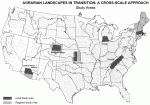The Biocomplexity Program
Agricultural Landscapes in Transition: A Cross-scale Approach
In 2001, the Central Arizona-Phoenix Long-Term Ecological Research (CAP LTER) project, in collaboration with the Baltimore Ecosystems Study (BES) received funding from NSF’s “Biocomplexity in the Environment” program to hold a series of workshops to promote the integration of social sciences into long-term ecological research. It was hoped that this incubation grant would spark scientifically exciting interdisciplinary research that would bring together social, biological, and earth scientists to better understand human ecosystems.
One workshop, “Integrating Census, GIS, and Historical Methods into Long-Term Ecological Research,” led to six sites receiving a four-year award from the NSF’s Biocomplexity program. This project: “Agrarian Landscapes in Transition: A Cross-Scale Approach” or AG TRANS, is an interdisciplinary effort tracing the effects of the introduction, spread, and abandonment of agriculture at LTER sites, with cross-comparisons in Mexico and France. The main LTER sites involved in AG TRANS are: Central Arizona Phoenix LTER, Harvard Forest, Shortgrass Steppe, Coweeta, Konza Prairie, and Kellogg Biological Station. CAP leads this collaboration of ecologists, anthropologists, sociologists, and geographers, a collaboration expected to serve as a model for future integrative projects. Participating scientists include: Charles Redman (PI) and Ann Kinzig (CAP LTER), David Foster (Harvard Forest), Myron Gutmann (Shortgrass Steppe), Ted Gragson (Coweeta), Gerad Middendorf (Konza), Alan Rudy (Kellogg), and Peter Kareiva (The Nature Conservancy). Other participating scientists are listed at http://ces.asu.edu/agtrans/participants.htm.
AG TRANS aims to understand what happens when humans impose spatial and temporal signatures on ecological regimes and must then respond to the systems they helped to create, further altering the dynamics of the coupled system and affecting ecological and social resilience or vulnerability. Six LTER sites representing differing biogeographic regions and contrasting agrarian transformations will identify and quantify the ways in which agrarian transformations differ across regions and time and how these variations explain cross-scale patterns.
Expectations are that this multi-scale study will serve as a pilot project for cross-site, interdisciplinary work and lead to a better understanding of the mechanisms that govern ecosystem dynamics. AG TRANS is off to a great start and, we expect it to have a strong positive impact on the entire LTER network. Our overall objective is to better understand the interactions and relationships among and between ecological, social, and geophysical influences on changing agrarian landscapes. To achieve this goal, we will examine these changes and forces at varying temporal, spatial and organizational scales and focus on processes that act on long time scales and legacies in the landscape. The project also promises innovations in the area of integrated data management (across disciplines and sites) and K-12 education, where we will develop curriculum that parallels the research of scientists looking at the agricultural-urban interface. Partnering with The Nature Conservancy will allow us to test applicability of our results to conservation planning.
We have outlined ambitious, yet realistic, objectives for our first year. Our goal for Year 1 is to create baseline sets of spatial, historical, and ecological information about the study areas and a first iteration on a series of models to explain the processes underlying observed transformations. Social, demographic, economic, and political information is being assembled under the direction of Myron Gutmann; regional ecological information is being assembled by a team directed by Peter Kareiva; and extant remote sensing and GIS data is being collected by a CAP team (Will Stefanov and Maik Netzband). Several modeling efforts are being coordinated by Peter Kareiva, Ann Kinzig, Bill Parton, and Marty Anderies. Narrative case studies for each site are also being prepared and will be assembled into a book by David Foster and Charles Redman.
In addition, Charlene Saltz and Monica Elser (CAP) are crafting K-12 outreach activities with John O’Keefe (Harvard Forest) and Ted Gragson (Coweeta). We expect that the various data- collecting efforts will help provide a context for understanding the processes we are studying and that the initial modeling efforts and case study narratives will help direct the future stages of data collection and analysis. We believe that AG TRANS will demonstrate the value of these approaches and contribute to their refinement across the LTER network and elsewhere.
Another potential contribution is our plan to integrate qualitative approaches with the more frequently applied quantitative approaches of LTER studies. We are planning to host a session at the ASM meeting this September in Seattle. Although it will still be early in the project, we hope to have enough together to stimulate interest across the network and solicit useful input.

 Enlarge this image
Enlarge this image